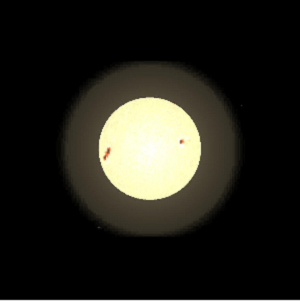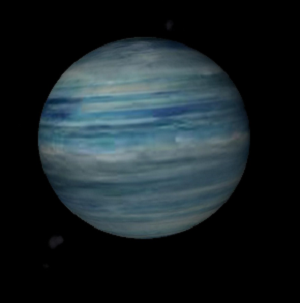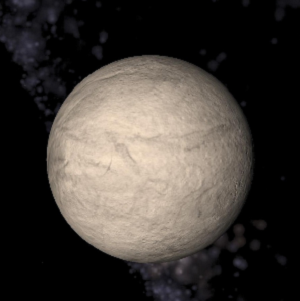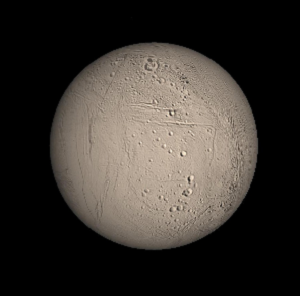BY LETTER
Amida System, the
 Image from Radtech497 |
Mass: 1.902e+30 kg
Radius: 4,062,065.701 km
Absolute magnitude: 1.869
Luminosity: 5.988e+27 W
Temperature: 4,750.466 K
Rotation period: 38.014 days
Age: 11.806 Gyr
Metallicity, [Fe/H]:
Planets: 6
On 10 Kepler 9871 A.T., the wandering transapient starship Eien no Gakusei (Japanese for "Eternal Student") broke nearly five centuries of self-imposed radio silence with the announcement e had discovered evidence of an extinct xenosophont civilization located on a moon orbiting the largest world in a very old K0IV subgiant's planetary system. The star, designated C2306265-085103 by the RAdial Velocity Experiment (RAVE) survey of 33 A.T., is a member of the so-called "Aquarius Stream" of stars that marks the demise of a dwarf galaxy whose core has been identified as the Omega Centauri globular cluster. This dwarf galaxy collided with and was absorbed by the Milky Way about 700 million years ago.
This civilization, dubbed HIE294PZE, left behind artificial cave-like structures connected to naturally-occurring caverns, often accompanied by patterns of indentations etched into polished rock faces. No further evidence of tools or other technological artifacts has been found, nor any unambiguous fossil record.
Star
The yellow-orange subgiant, named "Amida" by Eien no Gakusei after the ancient Japanese "Buddha of Infinite Light," is estimated to be about 11.8 billion years old and is now nearly 700 million years past the end of its Main Sequence lifetime.Coordinates (G10600)
Right Ascension: 23h 06m 37.804s
Declination: -08° 48' 48.504"
Distance from Sol: 7131.259 light years
C2306265-085103
Examination of the star, which is slightly more than five and five-sixths times the radius of Sol, but only 95.906% of its mass, indicates that hydrogen fusion is occurring in a relatively thin shell surrounding a core composed mainly of inert helium. It is believed that the star was originally a G6V yellow dwarf. Although fusion has turned the hydrogen in the core into helium, most of the outer layers of the star are made of hydrogen, including the layer immediately surrounding the core. The helium core also continues to generate energy by gravitational contraction. If the Main Sequence can be considered the "hydrogen core fusion" stage of a star's life, the first stage after the Main Sequence is the "hydrogen shell fusion" stage. During this stage, the rate of nuclear fusion is much higher than during the Main Sequence stage.
While these internal changes are occurring in the star, its outer layers are also undergoing changes. Since the energy being generated in the shell is more intense than was produced by the core during the core hydrogen fusion (Main Sequence) phase, the outer layers of the star experience a greater pressure. This increased pressure causes the outer layers of the star to expand significantly. As a side effect of this expansion, the outer layers of the star cool down because they are now farther away from the energy source (the hydrogen shell around the core).
Spectroscopic analysis has revealed unexpectedly high concentrations of silicon, iron, and other heavy elements in Amida's outer envelope, a clear indication that at least one planet has been engulfed and consumed by the star.
Planetary System
 Image from Radtech497 |
Semi-major axis: 0.115 AU
Orbital period: 14.452 d
Radius: 13,869.178 km
Mass: 2.897e+25 kg
Albedo: 0.068
Temperature: 1,601.816 K
Rotation period: 14.452 d
Moons: None
 Image from Radtech497 |
Semi-major axis: 0.243 AU
Orbital period: 44.669 days
Radius: 2,689.714 km
Mass: 5.157e+23 kg
Albedo: 0.117
Temperature: 1,087.163 K
Rotation period: 44.669 days
Moons: None
 Image from Radtech497 |
Semi-major axis: 0.781 AU
Orbital period: 257.252 days
Radius: 72,799.633 km
Mass: 1.566e+27 kg
Albedo: 0.218
Temperature: 588.279 K
Rotation period: 257.252 days
Moons: None
 Image from Radtech497 |
Semi-major axis: 5.083 AU
Orbital period: 11.688 yrs
Radius: 81,656.161 km
Mass: 4.024e+27 kg
Albedo: 0.293
Temperature: 224.855 K
Rotation period: 10.104 hrs
Moons: 56
 Image from Radtech497 |
Semi-major axis: 7.353 AU
Orbital period: 20.356 yrs
Radius: 4,672.796 km
Mass: 1.513e+24 kg
Albedo: 0.681
Temperature: 153.223 K
Rotation period: 17.925 hrs
Moons: 8
 Image from Radtech497 |
Semi-major axis:15.361 AU
Orbital period: 61.466 yrs
Radius: 2,251.342 km
Mass: 1.692e+23 kg
Albedo: 0.747
Temperature: 100.041 K
Rotation period: 33.369 hrs
Moons: 5
The Amida system formed from the collapse of a Giant Molecular Cloud somewhere within the dwarf galaxy whose core would later become known as the Omega Centauri globular cluster. If Daibutsu formed at or near the "frost line" of Amida, then it would have formed at or near 1.059 AU and subsequently migrated outward. Similarly, Akuma probably formed further away from Amida and later migrated inward. The rocky worlds that likely formed starward of Daibutsu's current orbit were probably either ejected from the system or were ground into dust and rock in collisions whose debris later collected to form the asteroid belts. Kanzeon likely formed slightly farther away than did Daibutsu, but it migrated inward rather than away from Amida. After the planets had essentially been formed, Daibutsu's gravity caused the orbits of the remaining planetisimals to become increasingly elliptical; this ejected some, while causing others to collide when their orbits crossed. Tidal effects over the past 11.806 billion years have long since circularized the orbits of the planets and other objects in the system, and whatever inclinations those orbits once possessed are but distant memories now.
Appears in Topics
Development Notes
Text by Radtech497
Initially published on 16 July 2013.
Initially published on 16 July 2013.






